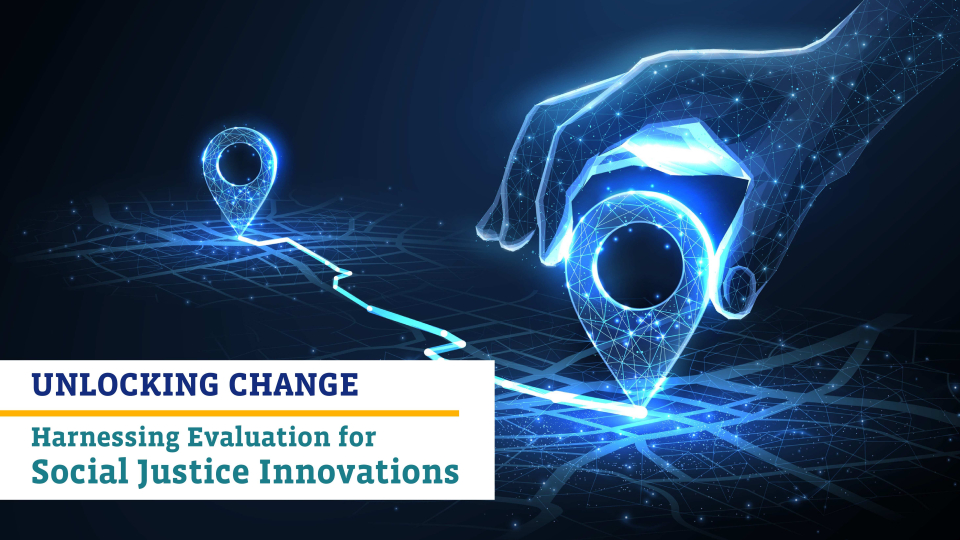Innovation is central to the work we do at CPE and to social justice more broadly; however, scaling innovation is notoriously challenging—over 90% of innovation projects across all types of organizations fail. This is particularly difficult for social justice nonprofits: the political and societal will to innovate has a narrow window to ensure success, and innovations must go beyond profit maximization; they must shake the status quo, as is the very nature of our work. In CPE’s webinar, Unlocking Change: Harnessing Evaluation for Social Justice Innovations, we discussed these challenges and how to implement innovations with the highest likelihood of success.
The webinar highlights research from our recently published white paper The Journey: How to Scale for Impact with Social Justice Innovations. The white paper integrates evidence-based practices from the disciplines of product development, implementation science, and project management in a comprehensive, easy-to-use framework that:
- Describes the necessary foundation for an innovation to be viable with measurable impact
- Outlines the steps to scale the innovation
- Clarifies the conditions necessary at the outset for a viable innovation to be scalable
“Evaluation doesn’t happen in a vacuum; it needs to be responsive to on-the-ground conditions,” says Rubin Ortiz, Ph.D. and Director of Research and Evaluation here at CPE. “Uncertainty is part of the effort. The role of evaluation is to capture success… we want to know why something worked and how we can repeat it. When something doesn’t go according to plan, that is also valuable information. From an evaluation standpoint, the outcome isn’t as important as capturing everything we can so we can build upon it. The uncertainties are where the learning takes place.” Successful innovation requires built-in feedback systems that incorporate metrics for tracking progress over the course of the innovation’s entire lifecycle to make sure researchers and developers are implementing learnings and adapt as-needed.
Equally important as tracking one’s progress is thoughtful stewardship of the resources one already has—including one’s staff. As Christina Peterson, Ph.D. and Survey Statistician at ICE, remarked, “There may be different tolerance for uncertainty at different stages of scaling. Early on, you might have to sensitize stakeholders to uncertainty while later on, as the project matures, tolerance surrounding uncertainty might be lower. Matching methods to what’s tolerable for those we’re working with is key; we can’t expect too much from our methods, data collection, or people depending on the stage of development.”
Before one can demonstrate impact, one must design for impact, and that means comprehensively assessing the resources at an organization’s disposal and creating an innovation plan that aligns ambition with the team’s finite resources, iterating and responding based on changing conditions. All this to say, innovation is necessarily volatile. For example, though there was huge momentum following the 2020 uprisings that stemmed from the murder of George Floyd, the large changes protesters demanded have failed to materialize. If anything, we’ve backpedaled, with “tough on crime” narratives dominating over reform in public safety discourses. External dependencies outside of our control often shape innovation: now, public safety advocacy has to address this rhetorical and political shift while still attending to the real needs of Black communities suffering under burdensome policing. Innovations must shift in response to the data and conditions that surround them.
Effectively designing for and demonstrating impact for a given innovation allows teams to disseminate their innovation thereafter by making strategic and data-driven decisions to scale up to expanded partners and audiences. While discussed at length in the webinar, these milestones are mapped out, literally, in the white paper and its companion brief.
In the webinar, we examine the process of scaling and the allocation of resources such that we can better ensure success in the nonprofit world and, ultimately, enact meaningful change. The roadmap presented in The Journey: How to Scale for Impact with Social Justice Innovations provides a visual counterpoint to the webinar discussion, a model to begin systematic and data-driven dissemination practices that have worked for us and will work for nonprofits elsewhere.
Scaling for Innovation Resources:
- The Journey: How to Scale for Impact with Social Justice Innovations White Paper
- The Journey: How to Scale for Impact with Social Justice Innovations Companion Brief
- Unlocking Change: Harnessing Evaluation for Social Justice Innovations Webinar

Individuals like you power all of our work. Consider donating today to support programming like this and other critical public safety redesign work.

